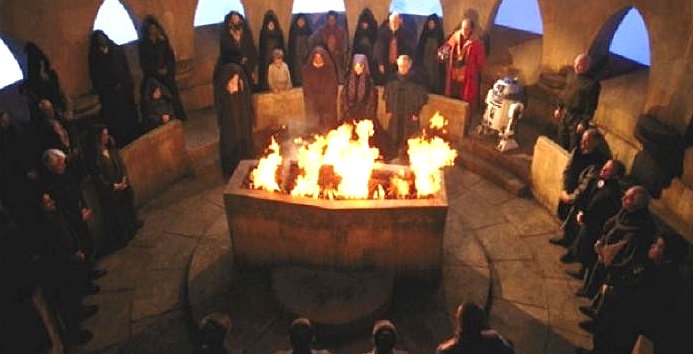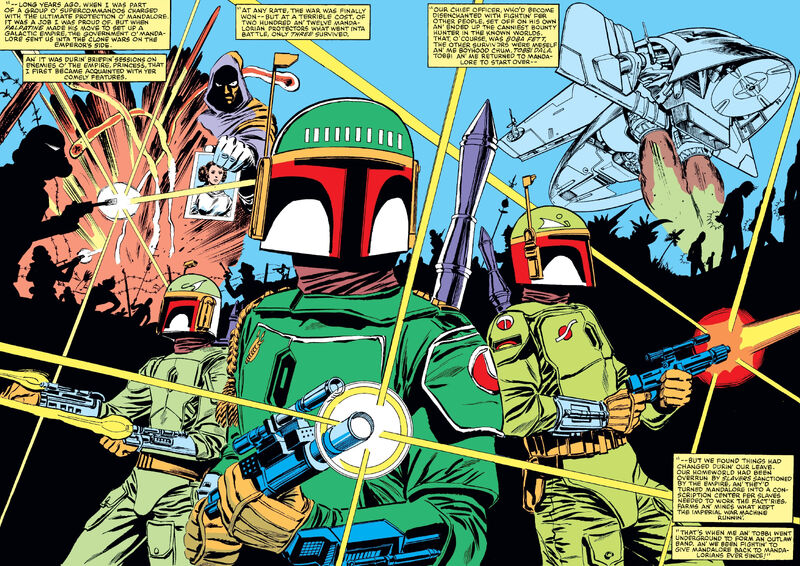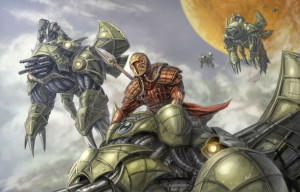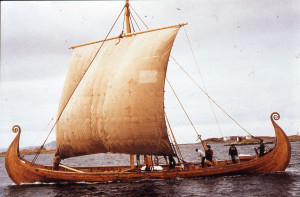
Character deaths have been part of Star Wars from the very beginning. We, as fans, don’t always like that our favorite character is no longer present in universe, but we can learn to accept them and objectively look at what works and doesn’t work for character deaths. Today we’ll look at movies vs. the EU and I look forward to your comments afterwards!
The Movies:
Jinn: “Obi-Wan. Promise…Promise me you will train the boy.”
Kenobi: “Yes, Master.”
Jinn: “He…is the Chosen One. He…will bring balance. Train him…
Qui-Gon Jinn in the mentor role of the Prequel Trilogy is one of the first character deaths you’ll come across chronologically in the movies. To be honest I’m a little on the fence about his death. I hate to start off on the fence and I promise to not be on the fence on the others. Ultimately I feel like Jinn should’ve waited for Obi-Wan Kenobi. Why would you take on a Sith 1 on 1 when you could take him on 2 on 1? That’s not logical to me and is what puts me on the fence. I think his death did much to boost Kenobi’s character. We know that Kenobi is supposed to be special and it takes a special Jedi Master to train the chosen one, Anakin. Having Jinn die and Kenobi beat the Sith that took out his master 1 on 1 does quite a bit to help the viewer believe in Kenobi. So while I think Jinn’s death is necessary I don’t like how they made him quite stupid in the end and not wait for Kenobi.
“I don’t know you anymore. Anakin, you’re breaking my heart!
You’re going down a path I can’t follow!“
Padmé Amidala’s death isn’t even one I’d like to discuss. In the first two movies she is such an amazing and strong heroine that the gross misuse of her character in RotS makes me ill. It was so frustrating to watch her utter the quote above and know that it meant they were going to have her die in a silly way. I think I would have even accepted Anakin killing her when he choked her over having her give birth and hearing the medical droids saying that she is perfectly healthy but dying of a broken heart. It is an unbefitting death for your heroine to die from a broken heart.
“You can’t win Darth. If you strike me down I shall become more powerful than you could possibly imagine.”
Obi-Wan Kenobi’s death is exactly how I imagine a hero’s death. He distracted the bad guy so that the future of the galaxy could escape from the Death Star. Kenobi achieves the ultimate victory over the Sith because he robbed Vader of actually killing him as well as figuring out how to remain behind as a force ghost and continue to influence the events of the galaxy. He also got to rub it in Vader’s face with the quote above. Kenobi’s death after a life lived to its fullest was the right way to kill off a hero.
“You already… have, Luke. You were right. You were right about me.
Tell your sister… you were right.”
Vader/Anakin Skywalker is arguable to be included here but I am going to include it since it is one of my favorites (along with Kenobi’s) from the movies. Despite not being able to show facial expressions, one can clearly tell how conflicted Vader has become over Luke and the Emperor killing Luke. He steps in to sacrifice himself and succeed at what every Sith aspires to do: kill their Master. But in the process he also saves Luke and ultimately the galaxy, so was he redeemed? Was he acting still as a Sith with their desire to take out their Master or was he rejecting the Sith and acting out of love to save his son? It is so deliciously ambiguous in the moment that I love it. Obviously we see Vader proclaim he was redeemed and he shows up as a force ghost with the other Jedi later in the movie, but in the moment it is completely up to the viewer to decide if Vader died as a hero or not.
The Expanded Universe:
“I love you, Chewie.”
“I should have told him that myself! He saved my children! He was always there for them, he died for them! And I never told him.” ~Han Solo
Chewbacca’s death is very unpopular in the EU. He was the first major movie character to be killed off and I loved it. I understand my opinion is not really on par with how others feel, but I can’t help it. Star Wars became exciting again with the thought that someone could die. There is also no better end for a hero than to sacrifice oneself for someone else. I will grant that it seems a little strange since we know Wookiees have a bit of jumping ability to think that Chewie couldn’t have tucked Anakin Solo under his arm like a running back and leapt aboard the Falcon. However, I appreciate what the authors were trying to do and how they gave Chewie a noble, hero’s death by having him complete his life debt to Han and making the ultimate sacrifice for Anakin Solo, who was supposed to be the future of the Jedi. A last stand that includes bellowing in defiance at a moon as it comes down upon you is the right way to kill off a hero.
“I witnessed the death of perhaps the greatest of them all, the one called Anakin Solo, who gave his life so that the ones he loved might live.” ~Nom Anor
Again the EU gets a hero death right. You can whine all you want about how Anakin Solo shouldn’t have been killed off and I’d probably agree with you, but I am looking at how it was done and it was done well. I love the concept of Anakin’s death: to sacrifice himself for not only the lives of his friends and the girl he loved but the Jedi around the galaxy. During the Mykr mission at least four of the Jedi members were killed and multiple Jedi were wounded, including Anakin. He stayed behind to delay the Vong so that the others could complete the mission to kill the Voxyn queen and escape. Anakin fully immersed with the force and truly became the light of the Force in order to defeat the Vong but was unable to recover from such an immersion of Force energy. What happens to the Jedi he sacrificed himself for cheapens that sacrifice but in the moment Anakin Solo was awarded a hero’s death.
“I am Ganner. This threshold is mine. I claim it for my own. Bring on your thousands, one at a time or all in a rush. I don’t give a damn. None shall pass.“
Ganner Rhysode may have the most epic death in Star Wars. I challenge my readers to find a more epic last stand for a Star Wars character. The quote is a bit of a rip off from LotR and Gandalf, but I’m willing to forgive that because once again the Star Wars EU killed off a hero correctly and gave them a spectacular last stand. While reading Traitor I was actually frustrated that Ganner was given such an awesome death. I really felt like another Jedi who was more fully developed should’ve been given this death. I think it would’ve been close to perfect for it to have been Kyp Durron instead to finally atone for his wrong doings in the destruction of Cardia to sacrifice himself so Jacen could kill the world brain and the Jedi could finally start to retake the galaxy. Instead the EU once again kills off one of the younger generation characters. Ganner takes out thousands of Yuuzhan Vong warriors with Anakin’s lightsaber becoming a legend and nightmare the Vong tell stories about for some time. Definitely the right way to kill off a hero.
- “You think…you’ve won, but Luke will crush you…and I refuse…to let you…
- destroy the future…for my Ben.“
Legacy of the Force begins a terrible downturn for hero deaths in the EU. The death of Mara Jade is arguably one of the worst in the history of Star Wars. The “logic” of Jacen’s sacrifice was so far off that even the apologists have a hard time with her death. Just the fact that Jacen felt the need for a sacrifice to truly become a Sith didn’t work for me. At the time of LotF we’ve had over a hundred books as well as numerous comics. We also had the PT where we experienced Anakin Skywalker’s fall and his transformation into Vader. At no point do we see Sith dwell on the concept of a sacrifice in order to become a true Sith. Usually the Sith are so self-involved that there would be nothing to sacrifice. So to begin with, Jacen needing a sacrifice is flawed and then choosing Mara as his sacrifice makes no sense. I acknowledge the argument made that Ben’s admiration is the sacrifice but that could have been accomplished in a different way. There was no reason to kill off a hero for Jacen to be a Sith.
Her death was brought on by the elimination and underdevelopment of characters Jacen’s age along with an unwillingness to kill off Tenel Ka for some reason. Luke, Han and Leia were out of the question. Jaina as well since they can’t kill off all the Solo children. They made the right choice by not killing off the next generation of Allana and Ben. So again, why the need for a killing sacrifice? Jacen was already believable as a bad guy and one turning Sith. The authors had Jade make the mistake of feeling like she had to do this alone which also isn’t logical. She has a literal army of Jedi to use and she decides that she alone can take out Jacen. If you’re going to use her Hand of the Emperor’s training as an excuse then you can’t have her fail. She was too good at what she did for the Emperor to have her taken out by a poison dart, because Jade would’ve thought of that trick herself.
Mara’s death and attempt to save Ben’s life also almost cost Ben his life. After her death he plotted to kill Jacen himself and if he had continued down that path he would have taken Jacen’s place as a dark Jedi at the very least. Given what we’ve seen from the direction of Star Wars after LotF, Mara’s death seems like a horribly executed way to get Luke free from him wife in order for him to retire. Yup…that makes total sense…
I had originally intended to discuss Kenth Hamner as well, but the more I wrote and the more I thought about it this one question kept bugging me. Hamner is known as a Jedi who is bland but does his duty with honor, grace and strength yet in the end is written as almost traitorous to the Jedi order so much so that they decide to do something uncharacteristic of Jedi and kill him instead of capturing or disabling him. Hamner believed he was doing the right thing and trying to keep the Jedi from treason. So I’m going to instead pose that question to you. Can we consider Hamner’s death the death of a hero?









